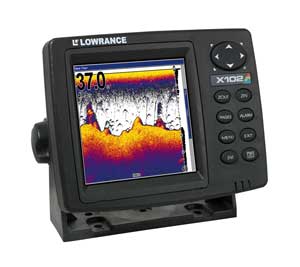
Turkey season ends almost as soon as it gets started, but late-season hunting can be the best time of year.
Traditional dual-frequency transducers are designed for deep-water use. They include a low frequency (usually 50 kHz) because it penetrates depth better than higher frequencies. Low-frequency sonar transmissions tend to have a wide, 40- to 60-degree beam angle, and can’t separate targets or show bottom detail as well as high-frequency transmissions. They also don’t work well at faster boat speeds; in fact, they tend to lose the bottom as a boat planes.
Higher frequencies are better at separating suspended targets and showing bottom detail, and they can track the bottom at the fastest speeds most boats can manage. The most popular high frequency is 200 kHz because it offers great performance over a wide range of conditions.
Higher frequencies don’t penetrate depth as well as lower frequencies, so in keeping with the deep-water theme, the high frequency side of these transducers focuses the 200 kHz beam at a narrow angle. This concentrates the sound for better depth penetration, and the narrower beam provides a more tightly focused look at what is directly below the boat in deeper water.
Dual-frequency sonar units traditionally display the results of high- and low-frequency pulses separately. You can look at the picture generated by the 200 kHz beam or the 50 kHz beam on a full-screen display or select a split-screen mode that shows them side by side.
Some sonar manufacturers, like Garmin, Humminbird and Navman, offer a combined view that electronically merges the echoes from both high- and low-frequency pulses into a single picture. This seems to combine high-frequency detail with the wider beam and deeper search capabilities of low frequency, and it works at high boat speeds.
Most of the things that make dual-frequency units a great choice for deep water work against them in shallow water. When searching for fish and fishy looking cover in freshwater lakes, we seldom look at water deeper than about 80 feet, and more commonly search water less than half that deep.
The 10- to 12-degree high-frequency beam common with dual-frequency transducers covers about a 6-foot circle on a 40-foot bottom. The rule of thumb for estimating the coverage of a beam this narrow is to divide any depth by 7 to find the diameter of the beam’s circle of coverage at that depth.
In comparison, the beam width of the standard, single-frequency, 200 kHz transducer shipped with most single frequency units is 20 degrees. The rule of thumb for estimating its coverage is to divide the depth by 3. It would cover a circle with a diameter of just over 13 feet on a 40-foot bottom.
This means that a fisherman using the 10-degree beam of a dual-frequency transducer in shallow water is searching with sonar’s equivalent of a spot light while an angler using a standard 20-degree beam is searching with the equivalent of a flood light. Who do you think will find what he is looking for first?
The 50 kHz low-frequency side of these transducers usually generates about a 45-degree beam. The rule of thumb for determining its coverage is easy: The diameter of the circle of coverage at any depth is equal to that depth, so it covers about a 40-foot circle on a 40-foot bottom.
This wide scanning angle can spot large structure faster, but it contributes to the reduced screen detail generally observed when using 50 kHz. Sonar has to convert everything it “sees” within its three-dimensional transducer beam into a two-dimensional screen picture.
The larger the area covered by the beam, the more stuff it is likely to detect and the more cluttered the screen picture becomes. Add the fact that low frequencies can’t separate objects like fish from structure, the bottom or each other as well as high frequencies can, and the problem gets worse.
Fish close to the bottom, for instance, are more likely to be displayed as a lump on the bottom or be completely lost in the bottom contour instead of being shown as a separate mark.
Adding a second, single-frequency, 200 kHz transducer with a 20-degree beam eliminates the shortcomings of using a traditional dual-frequency transducer in shallow water. Just switch to it for inshore and freshwater fishing, and switch to the dual-frequency transducer when going offshore.
If you have a unit that can merge soundings from both frequencies into a single image, use that mode in shallow water and forget about the extra transducer. If you seldom fish water more than 100 feet deep, you probably don’t need a dual-frequency unit at all.


